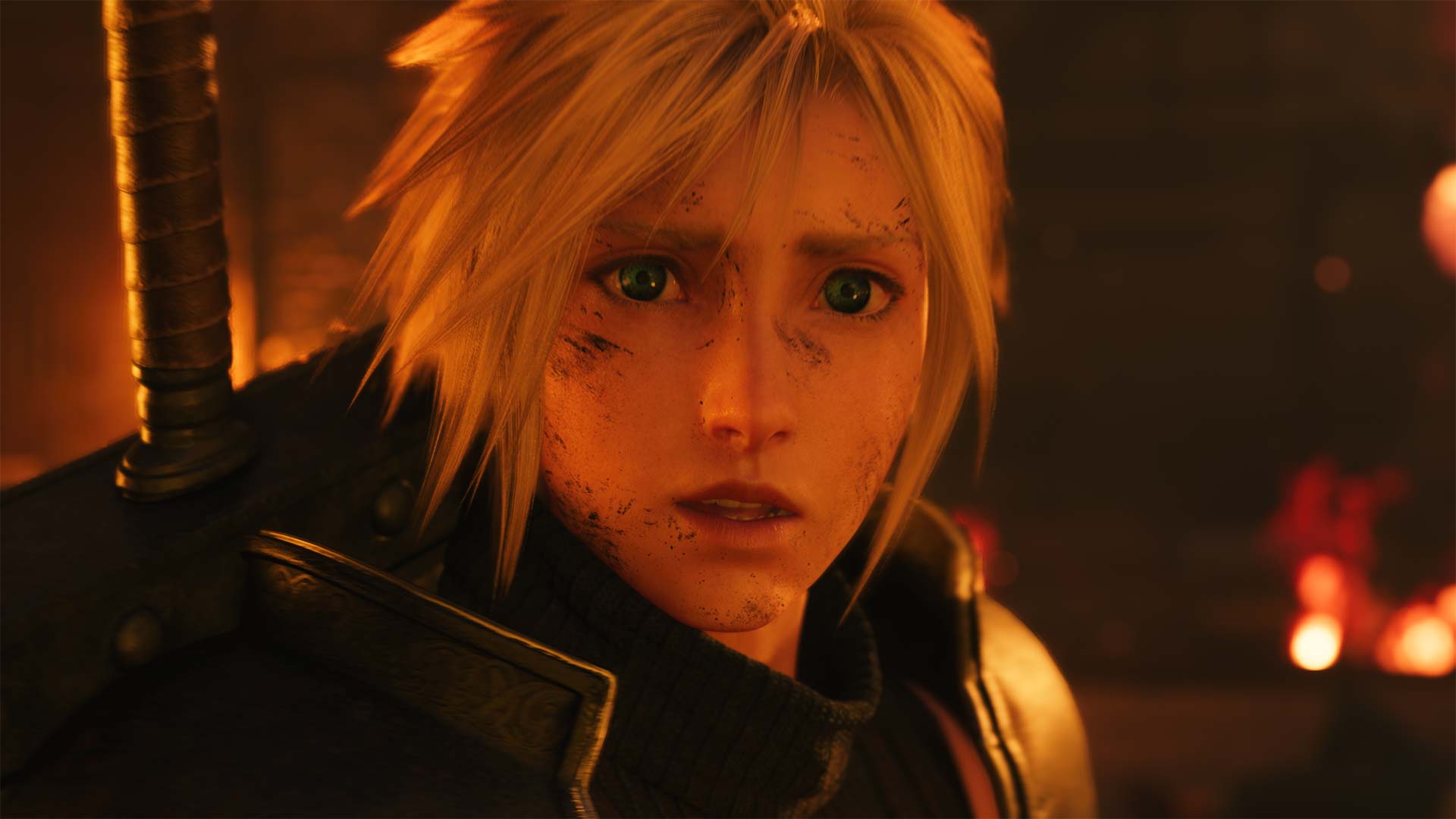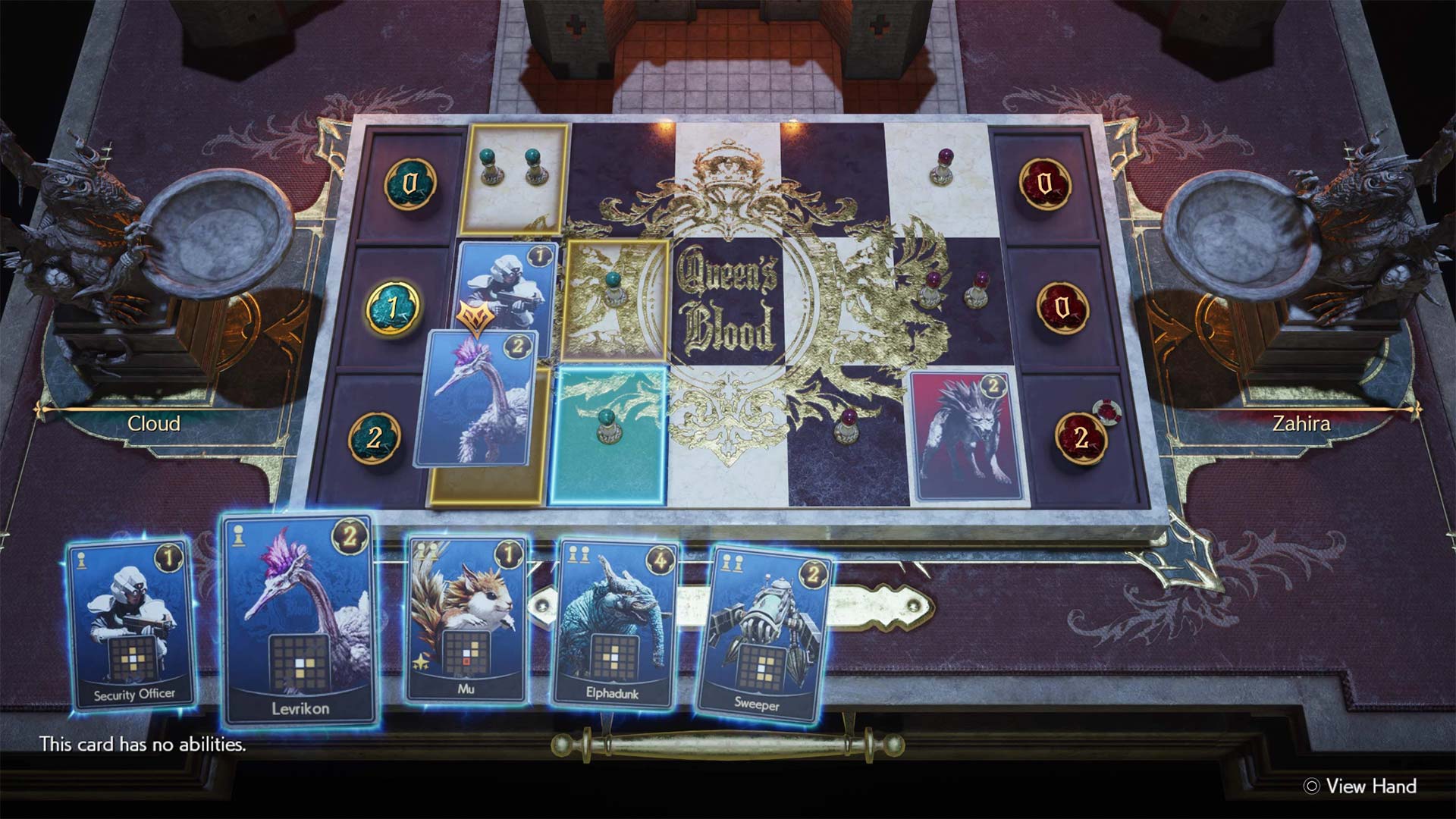
If I were to describe Final Fantasy VII in a single world, it would be “wonder.”
The wonder of taking in the ecological beauty of a planet on the verge of collapsing at the ruthless hands of a destructive megacorporation. The wonder of finding companionship amid that hardship and, through that, being able to overcome trauma and make life-changing discoveries about yourself. The wonder of playing around with the robust Materia character customization system. The wonder of hearing the next stirring piece of music from legendary composer Nobuo Uematsu.
So profound are these feelings that they quickly made FFVII my favourite game when I was 10 years old, and so has it remained for nearly 20 years. Truthfully, I never thought that anything could ever recapture all of that. Even 2020’s Final Fantasy VII Remake, as incredible and daring as it was, only accounted for the first five hours of the total VII experience.
Against all odds, then, Final Fantasy VII Rebirth achieves a similar sense of wonder as the original VII, and then some. Even after spending close to 100 hours in the second part of Square Enix’s trilogy of VII remakes, I’m still having trouble believing the action-RPG exists. Not only does it so perfectly distill the magic of first playing VII on the original PlayStation, but it also masterfully reinterprets and expands upon that seminal experience for the modern gaming landscape, significantly enriching my already unwavering love for the source material.
Like its predecessor, Rebirth redefines what it means to be a remake, with storytelling that operates on uniquely meta levels to deliver something wholly unique.
Through and through, it’s a monumental achievement unlike anything in gaming.
A deeper, more emotionally mature tale
Rebirth picks up immediately after the events of Remake with Cloud and friends resting in Kalm, a peaceful walled-off town just outside of Midgar, before continuing their pursuit of Sephiroth and trying to find out what’s he after. Here, Cloud takes the opportunity to dive into his history with the legendary warrior — something only alluded to in Remake — and explain his tragic downfall. In this section, you’ll see Cloud’s backwater hometown of Nibelheim, his early relationship with childhood friend Tifa, and more. As in the original game, this flashback is entirely playable, but it’s been dramatically expanded in Remake fashion.
And even within the first few minutes of this chapter, Rebirth drastically deepened my connection to the world of Final Fantasy VII. As you explore Nibelheim, you truly appreciate Cloud’s humble upbringing through what is easily one of the liveliest and most stunningly rendered towns I’ve seen in a game. Kids playing in the garden with chickens while excitedly talking about Cloud and Sephiroth’s arrival. People of all ages anxiously standing outside of town hall, hoping for a picture of Sephiroth. Going into Tifa’s house and seeing her cat’s food bowl, piano and photos with her dad, offering a glimpse into her life without her mother.
“…the big elephant in the room surrounding this game is the fate of Aerith.”
After a while, I noticed I hadn’t been clicking in the DualSense’s stick to sprint as I would in most games. Instead, I’d subconsciously turned Rebirth into a walking simulator, slowly soaking in every inch of Nibelheim to the tune of Uematsu’s hauntingly melancholic “Anxiety.” It’s by seeing the teeming life and personality of this town that its eventual destruction at the hands of Sephiroth — depicted with horror movie levels of chilling atmosphere — hits all the more, allowing you to dive into Cloud’s resulting trauma in ways the original game never could accomplish.
But this section also illustrates the high-quality environmental storytelling that is maintained throughout the rest of the game. From the quaint farm run by orphaned siblings and the bustling military-occupied city of Junon to the lavish seaside resort of Costa del Sol and gargantuan theme park built atop a dilapidated mining town, Rebirth shows all of the ways, both big and small, that the Shinra Electric Power Company’s fascism has affected the lands of Gaia. Every one of these areas is also rendered with the same level of gorgeous visuals, meticulous attention to detail and impressive NPC liveliness as Nibelheim, providing a constant reminder of what you’re fighting for on your grand journey.
But Rebirth isn’t all doom and gloom; far from it. Throughout Gaia, you can take on a wide assortment of entertaining minigames that includes Chocobo bird racing, target shooting, G-bike combat racer, the Rock’ Em Sock’ Em-esque 3D Battler, and piano playing (which people have already used quite marvelously). Amusingly, you can even unlock vacation wear and take a leisurely segway ride around Costa del Sol. But the best of these activities, by far, is Queen’s Blood. This new addition to the VII universe is all about strategically placing cards with different values to either boost adjacent spaces to play more powerful cards or block your opponent from throwing down theirs. I spent so many hours challenging every player I came across to build out my deck, meet quirky new faces and unpack the mystery behind the creator of Queen’s Blood itself. Those who have played Final Fantasy VIII know how addictive the Triple Triad card game can be (so much so that it was added to Final Fantasy XIV), and Queen’s Blood easily reaches those highs — it’s that good.
The significance of these side activities is twofold. First, they maintain the spirit of the original VII, which offered a hodge-podge of minigames, with Rebirth greatly improving upon them from both a mechanical and variety perspective. Those kinds of silly bits juxtaposing Sephiroth’s world-ending threat were a key part of VII, and Rebirth‘s got them in spades. More crucially, these distractions play into the central theme of Rebirth: the importance of living in the moment. Not only do they provide meaningful reprieves from the oppression of Shinra and Sephiroth’s villainous schemes, but they also prolong the inevitable: Rebirth‘s long-awaited finale.
Because, of course, the big elephant in the room surrounding this game is the fate of Aerith. Indeed, much of the marketing has centred around whether the beloved florist will live, die, or even see someone else perish instead, given Remake‘s bold promise of plot deviations leading to a so-called “unknown journey.” For many, Aerith was the first time we, as children, were really forced to confront the idea of mortality, and I have vivid memories of running around her church in the slums desperately trying to find a way to revive her. What we wouldn’t have given to get her back.

*That* moment… or is it?
Naturally, the climax of Rebirth — which covers the Forgotten Capital section from the end of the original VII‘s first disc — will upset some people simply by making changes of any size to one of gaming’s most sacred and iconic moments. But focusing so much on that is to miss the point entirely. Even if I didn’t find how Square Enix handles the final chapter to be effective (and, to be clear, it’s handled in a mostly delicate, if somewhat messy manner), what’s most important is how Rebirth pushes you to savour everything preceding it.
In a meta sense, knowing what happens with Aerith in the original VII actually reinforces this theme in a way that only a remake like this could. The time we have with all of these characters is precious because we aren’t guaranteed to see all of them in the third game. FFVII has always been about the beauty of life, and so the big questions surrounding Aerith only offer an even more thoughtful meditation on that. And where Remake admittedly added several levels to the Midgar section that felt like padding (such as the sadistic scientist Hojo’s late-game dungeon), Rebirth‘s vastly superior pacing ensures that the prolonged new sequences and the occasional fixed party configurations serve to better demonstrate the growing bonds between our heroes.
And so, every moment you spend in this world with your companions — whether it’s traveling halfway across the map to pick flowers with Aerith, playing 3D Brawler with an ultra-competitive Yuffie, or simply basking in the radiance of the sunset in Costa del Sol — feels purposeful in ways unlike any I’ve seen in gaming. Meanwhile, returning players like me who grew up with VII will find themselves far more closely connected to everything. Now that I’m older and have started to experience real loss (the relatively sudden deaths of both my dog and aunt in recent months) and better grapple with the impermanence of life, Rebirth‘s handlings of these themes now have a profoundly intimate resonance. Tying “No Promises To Keep,” the lovely main musical theme of Rebirth composed by Uematsu and powerfully performed by The Greatest Showman‘s Loren Allred, to Aerith only adds to the feels.
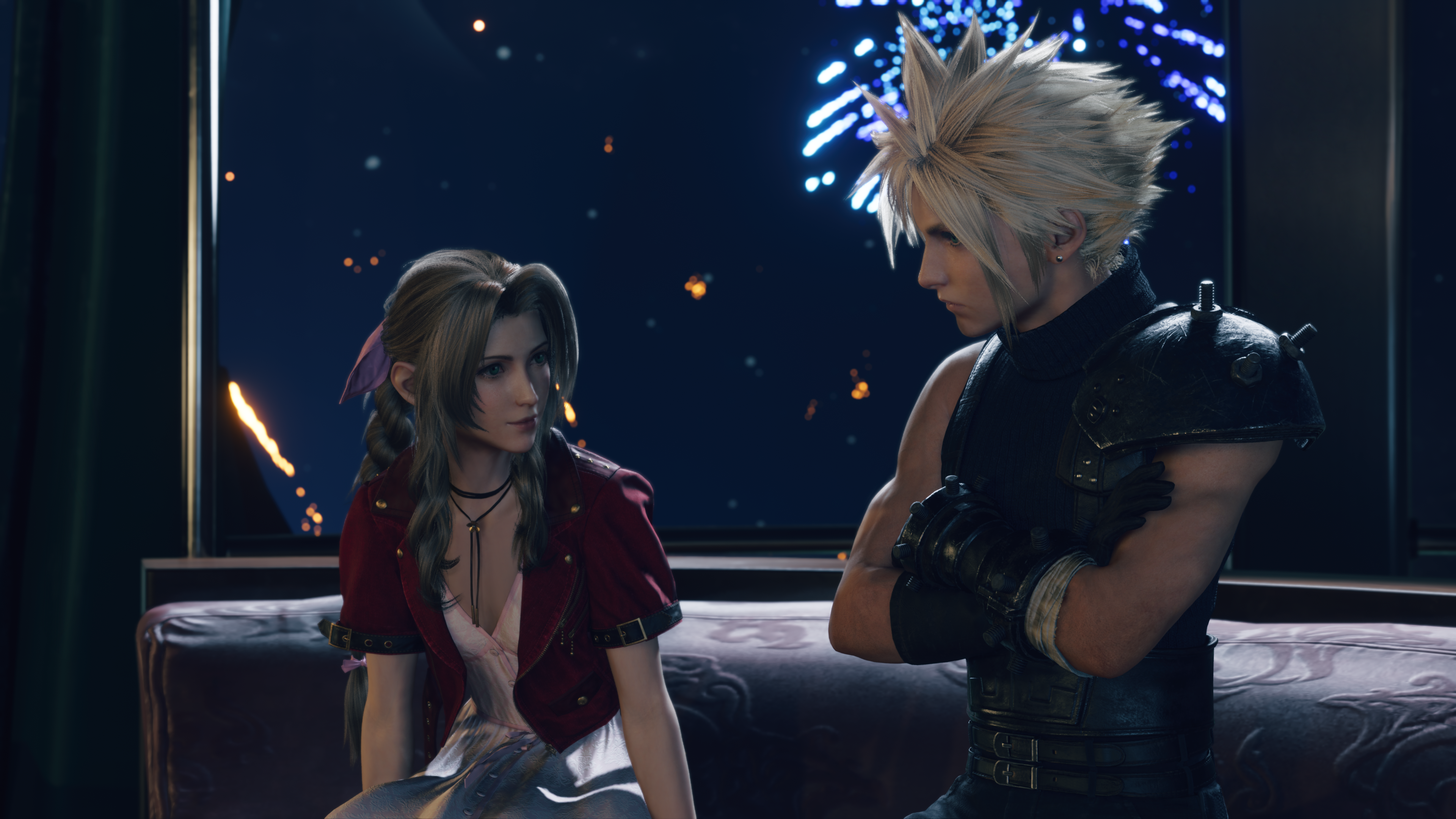 Beyond Aerith, the greater emphasis on spending time with characters also just lets you appreciate how strong the writing in this trilogy continues to be. After spending dozens of hours learning all of Cloud, Barret, Tifa and Aerith’s quirks and complexities, Rebirth lets us see how all of these characters, plus newcomers, have really come to feel like a genuine family.
Beyond Aerith, the greater emphasis on spending time with characters also just lets you appreciate how strong the writing in this trilogy continues to be. After spending dozens of hours learning all of Cloud, Barret, Tifa and Aerith’s quirks and complexities, Rebirth lets us see how all of these characters, plus newcomers, have really come to feel like a genuine family.
Once you’ve learned more about Cloud’s pain, Rebirth tantalizingly dives deeper into his increasingly fragile mental state, as sharply conveyed through Cody Christian’s excellent performance, which, in turn, further emphasizes Sephiroth’s effectiveness as a psychological villain. Tifa, for her part, has an equally compelling struggle as she tries to reconcile her and Cloud’s conflicting memories while continuing to serve as the team’s moral compass. And elsewhere, seeing firsthand the devastation Shinra has caused to Barret’s hometown — and his aching sense of guilt for his unwitting role in bringing it about — makes his hatred for the company, as portrayed extensively through his eco-terrorist actions in Remake, feel so much more sympathetic.
And that’s just for the returning playable characters. Red XIII, who was previously only a guest member in the final hours of Remake, has a much more prominent role here as a creature whose wise and soft-spoken demeanour belies a complicated family history. Cait Sith, an anthropomorphized Scottish cat that rides atop a stuffed toy Moogle, also fares far better here than in the original VII, where he was the least interesting party member. Thanks to its longer runtime, Rebirth offers many more scenes with him slowly bonding with the team, making their eventual in-fighting more impactful.
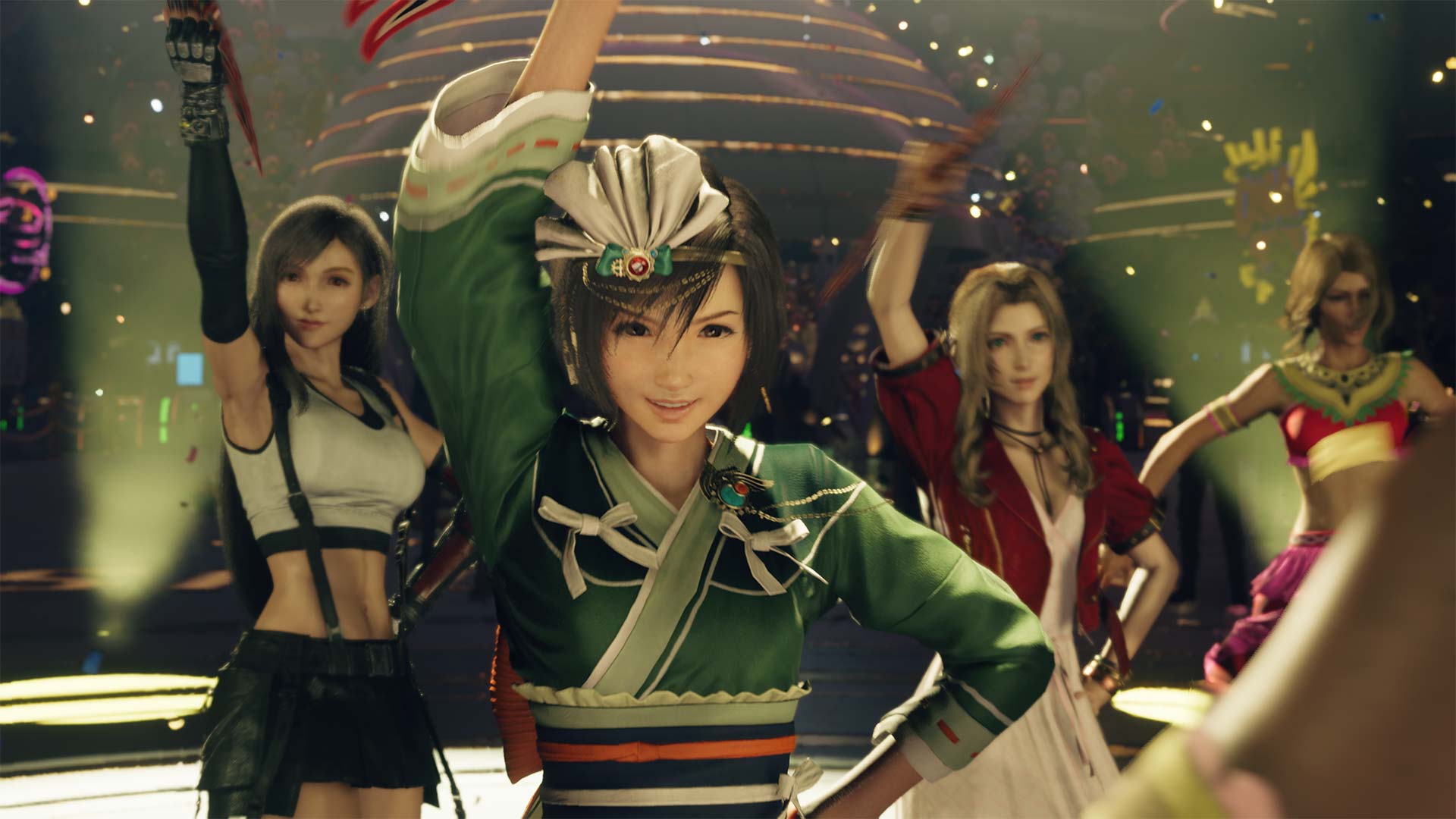
Yuffie (centre) brings an infectious energy to the team.
But the character who makes out the best is Yuffie. The young ninja was an optional party member in the original game (and introduced in this trilogy Remake Intergrade‘s Intermission episode), and she’s fully integrated into the main story this time around. The plucky teen is on a well-intended, if misguided, mission to gather magical Materia orbs for the war between her home country, Wutai, and Shinra. Admittedly, though, Rebirth doesn’t catch you up to speed on this backstory, so you’ll need to familiarize yourself with Intermission for this crucial context.
Otherwise, Yuffie brings a charming youthful energy to the proceedings, and her banter with the party — ranging from simple things like annoying Cloud with her braggadocious display of ninjutsu to an understandably naïve outlook on the nature of war — proves particularly engaging. (Shinra president Rufus, who made only a small cameo in Remake, also gets a dramatically expanded role here in which Square Enix unpacks the surprisingly tactical mind behind the effortlessly cool businessman through his conflict with Wutai.)
“Thankfully, this combat system has been fully retained for Rebirth and enhanced with several quality-of-life tweaks and truly game-changing new mechanics.”
Rebirth does, however, stumble with three of its supporting characters. Despite placing him on the cover, Square Enix does little to explain why you should care about former Shinra SOLDIER Zack in this story, and even playing the remaster of his VII spin-off prequel, Crisis Core, doesn’t provide much more clarity. Elsewhere, the roles of fan-favourite characters Cid and Vincent will likely disappoint some players. To its credit, Square Enix has stressed that the pair won’t be party members or even guest characters like Red XIII in Remake, but even still, how they sporadically come and go throughout the latter half of the story feels disappointing.
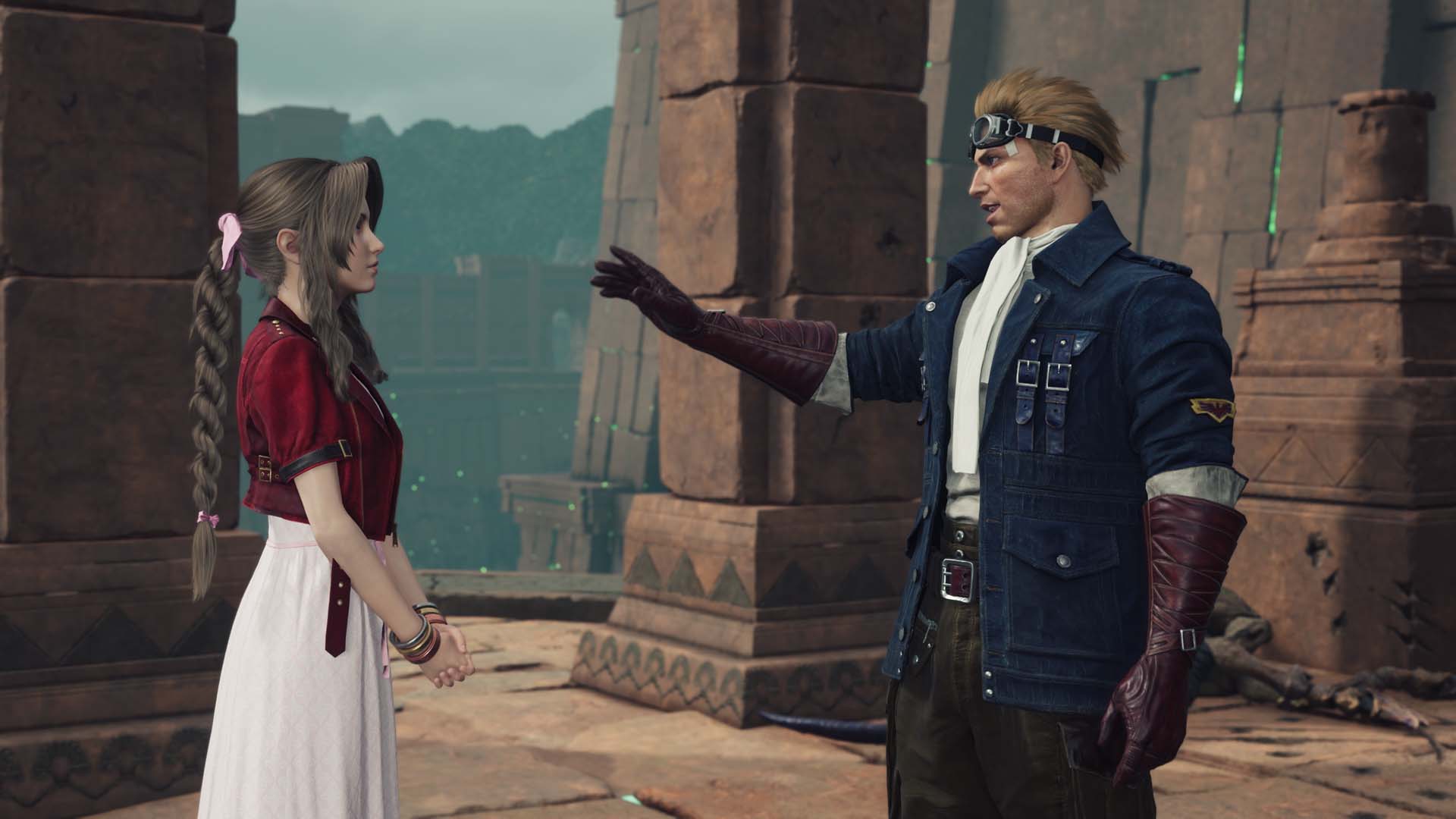
Cid says he wants to help Aerith, but we get little reason as to why.
Given how enigmatic Vincent is, as well as the fact that he, like Yuffie, was an optional character in VII, it’s at least more understandable that he’d play a background role, at least in this part of the trilogy. His introduction is also wickedly cool. But Cid, who was always part of the main story, feels woefully underused here. His first encounter with the party is an underwhelming deviation from the original game, and subsequent run-ins are brief and largely just see him chauffeuring you around in his airship, the Tiny Bronco. While it’s reasonable for Square Enix to want to save their grand debuts as playable characters for the next game, it still feels like a missed opportunity not to have had them be more prominent here. As it stands, it’s a lot of setup for a payoff that’s like four years down the line.
Same stellar combat, with some added Synergy
Among the many strengths of Final Fantasy VII Remake was its staggeringly versatile and intricate real-time combat system. Somehow, the team was able to marry the classic turn-based ‘Active Time Battle’ (ATB) mechanics of VII and its ilk with real-time commands in the vein of Kingdom Hearts or Final Fantasy XVI. In this case, more powerful maneuvers used ATB charges that you’d fill by using regular attacks and freely switching between one of three characters. At the same time, you could open a menu to effectively pause the game to issue specific orders to characters, which felt like the perfect happy medium between turn-based strategy and fast-paced real-time action. All of this works towards filling a Stagger meter to stun enemies and make them more susceptible to damage.
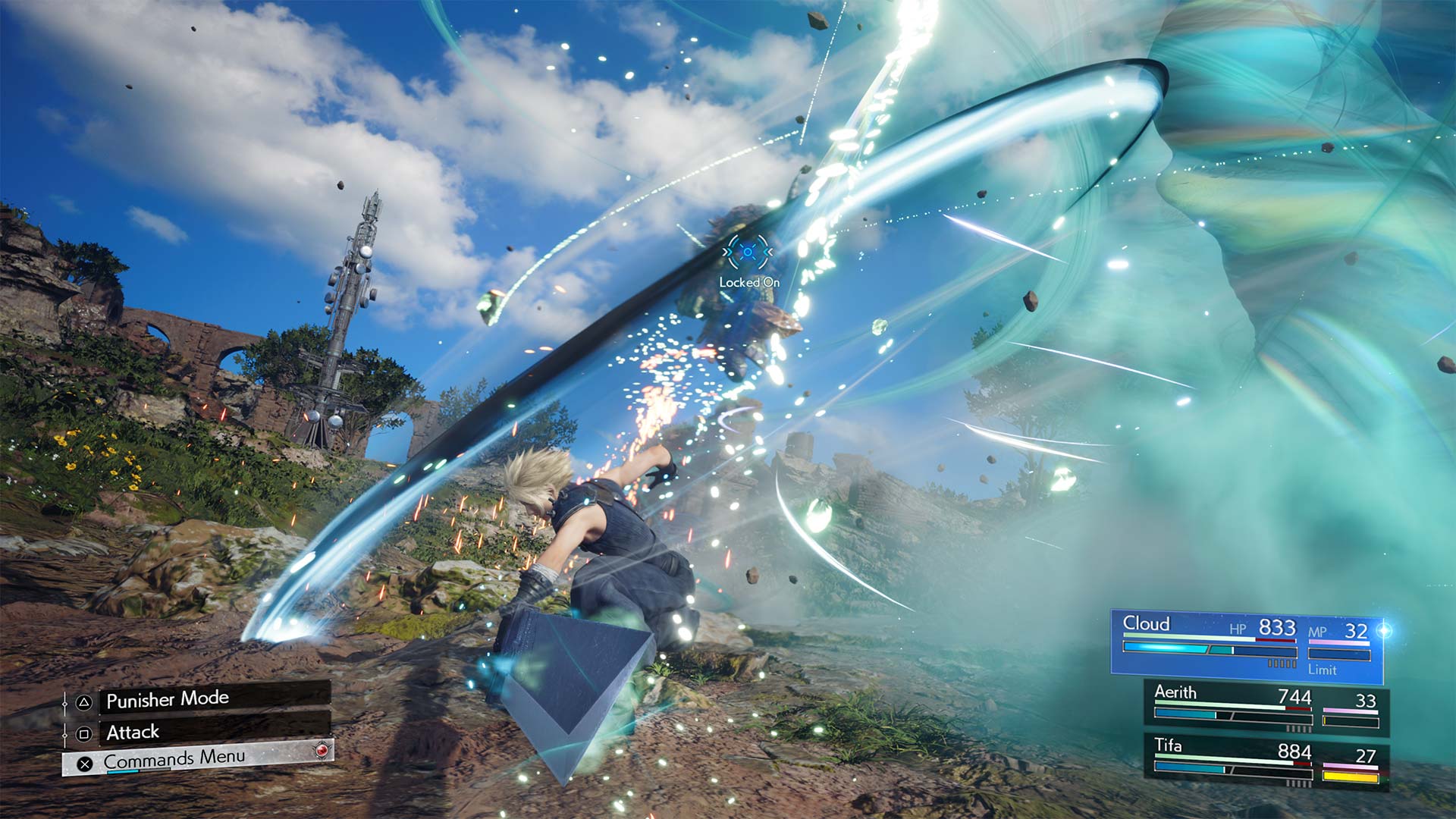
Cloud’s got some flashy new moves.
Thankfully, this combat system has been fully retained for Rebirth and enhanced with several quality-of-life tweaks and truly game-changing new mechanics. The biggest shortcoming of Remake, aerial combat, has been completely overhauled. In that game, melee-based characters like Cloud would automatically launch themselves toward airborne enemies, but the targeting and hit detection were wonky. In Rebirth, characters mercifully don’t do that anymore, with you instead initiating aerial combat through designated abilities. Take Cloud; some of his returning moves, like Triple Slash, can now be used on grounded and flying enemies, on top of some new attacks entirely.
What’s more, Cloud has been given a new ranged attack tied to a snappier and more responsive dodge that lets him hurl blades of energy from his sword. These will automatically hone in on enemies, including aerial ones, and landing enough of these in succession will even cause a ripple effect of damage. At the same time, tightening up these clunkier elements doesn’t suddenly make Cloud overpowered. For greater damage and Stagger build-up, you’ll still want to use characters more proficient in ranged attacks, including Aerith and Barret. Yuffie also fits that role nicely with her playstyle — which comes straight from the Intermission add-on — that mixes close-up shuriken slashes with long-range elemental magic once her weapon has been thrown. These ninjutsu spells do little damage, but are highly effective in building up Stagger, especially if you exploit elemental weaknesses.
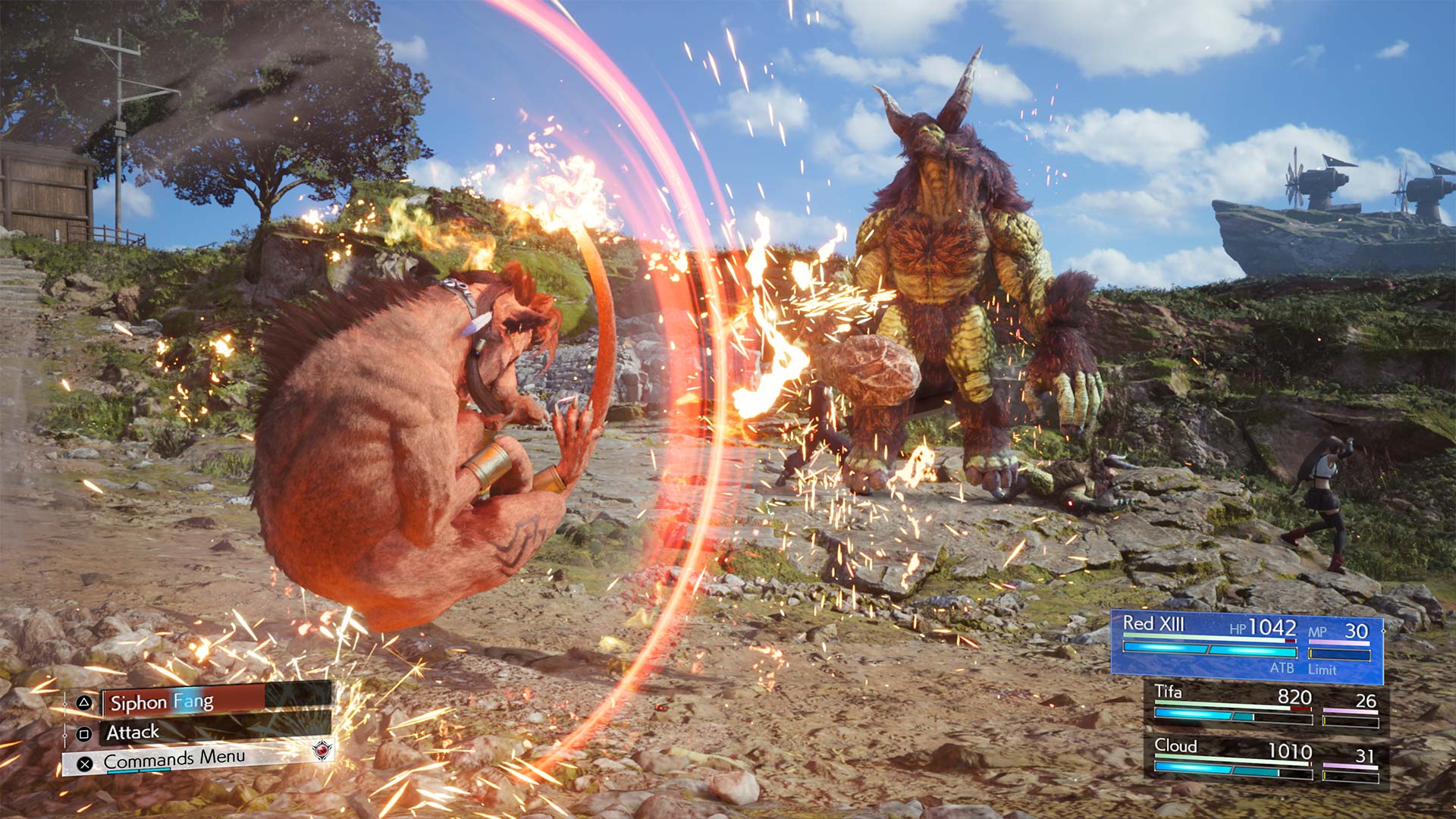
Remake’s Lab-Rat-Dog is back in a big way.
And while Yuffie isn’t a new playable character in the Remake series, the two that are, Red XIII and Cait Sith, add so much to the mix. In fact, I’d go so far as to say the former is my favourite character to use outside of Cloud. On a base level, he operates like a ferocious lion, bounding around on all fours and carrying out deadly fast claw attacks. It’s all centred around his unique ability, ‘Vengeance Mode,’ which is effectively a rage mode granting him more damage, faster movement and health restoration. On the flip side, many of his abilities expend Vengeance charges to either heal the party or replenish their ATB bars, resulting in a versatile kit that encourages you to make risk/reward decisions about how to use this gauge.
Cait Sith, meanwhile, is far less measured of a character, and that’s what makes him remarkably fun in his own way. Drawing inspiration from the original VII, some of his moves are focused around luck, including rolling a die and executing a random move (such as healing or offensive magic) accordingly. But what makes him even more chaotic in Rebirth is that his Moogle operates as a mount with its own mighty arsenal. Once you’ve built up enough ATB, you can summon the Moogle and gain access to more abilities, including trip mines, mighty punches and even self-detonation. With all of the other characters in Rebirth having more deliberate playstyles, I appreciated the zany “grab bag” approach to Cait Sith that also leans into VII‘s aforementioned silliness.
But the best addition to Rebirth‘s combat is the Synergy system. Drawing inspiration from Intermission, characters in Rebirth can perform special moves with one another while in combat. The most basic form of these are Synergy Skills, which cost nothing to execute and will even increase ATB but are very context-specific, such as Bodyguard, which allows Aerith to call in Cloud or others to defend her, and Counterfire, in which Cloud and Barret block before retaliating. (On that note, every character can also now perform a perfect block to not only nullify damage, but even increase stagger, adding further depth to an already robust combat system.)
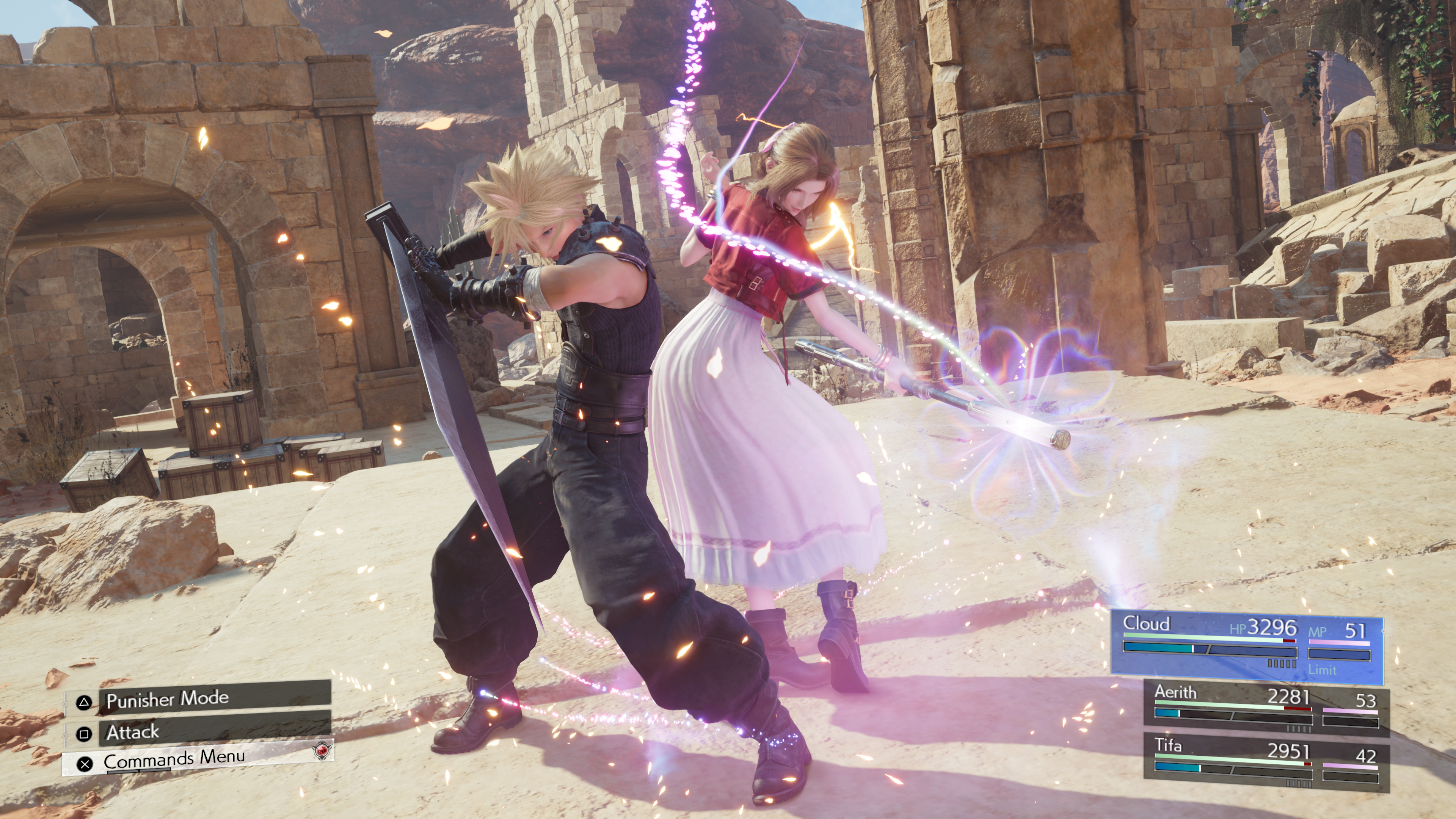
Firework Blade.
More useful, though, are the Synergy Abilities, in which two characters perform wondrously flashy team-up moves, such as Firework Blade, where Aerith imbues Cloud’s sword with magic that he then hurls at an enemy, or Cyclonic Kick, in which Tifa and Yuffie twirl each other around to kick the latter’s throwing star into an enemy. As a nice touch, these also delightfully emphasize the personalities of the characters, like the ever-vivacious Aerith quickly donning shades with Barret before shooting energy machine gun-style from her staff, or Tifa comically getting into a cat pose with Red XIII before pouncing. To use Synergy Abilities, you’ll need to expend ATB to carry out certain moves and receive Synergy charges. Obtaining the requisite charges with both characters will allow you to execute a given Synergy Ability. The brilliant part of this mechanic is that it challenges you to be efficient with your entire party, leveraging their ATB moves in tandem to stock up Synergy charges.
Besides dealing a good deal of damage, these Synergy Abilities all have bonus effects attached to them, like extending an enemy’s Staggered state or granting unlimited MP for a brief period. This adds even more on-the-fly strategy as you’ll have to weigh in on using a move that maybe isn’t as directly damaging but will improve your magic capabilities thanks to the MP boost. There’s also a non-offensive Synergy Ability called Unified Refocus that temporarily gives the two characters extended ATB bars to increase their combat potential. At the same time, the fact that these abilities initially require three charges in a given battle, and then five upon subsequent uses, ensures that they’re meaningfully balanced and useful.
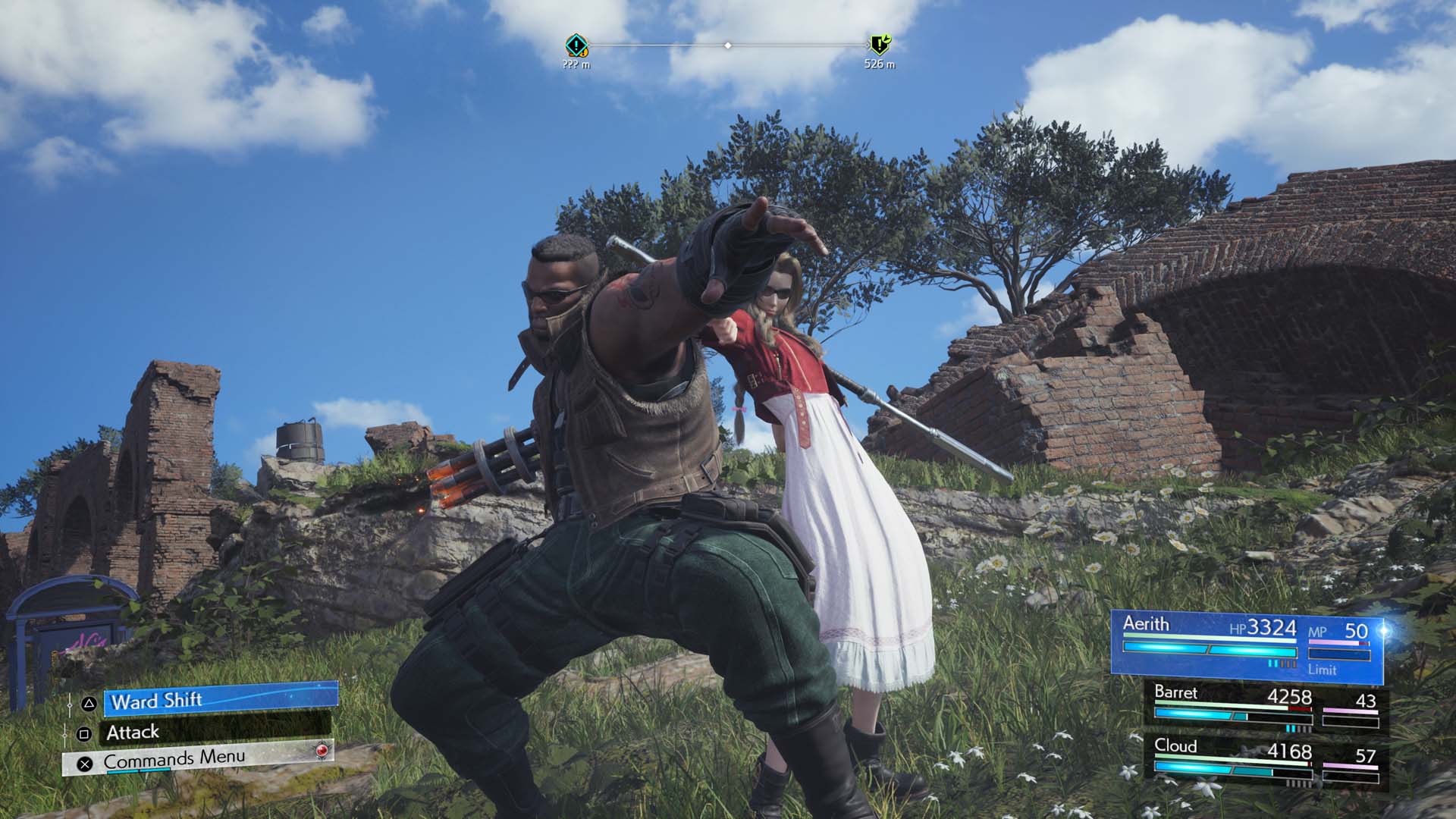
I love them so much.
Even greater depth comes from the Materia system, which remains largely the same but with some welcome new types. These include Level Up, which automatically upgrades a Materia to its more powerful next level when paired together, Fire and Ice which offers two elemental spells for the price of one and even special orbs that let your party members use their unique abilities automatically if you don’t want to actually manually input them.
Special mention must also be given to the music. Like Remake before it, Rebirth takes Uematsu’s stellar original score and enlivens it through some of the most sensational and intricate arrangements you’ll ever hear in a game, as well as some catchy new tunes for good measure. Composers Masashi Hamauzu and Mitsuto Suzuki, who also contributed to Remake‘s masterful music, mix in an eclectic array of instruments and genres to create a jaw-dropping 400-plus-songs soundtrack, and I’m desperate for it to drop on streaming services.
A magical world
For many players, myself very much included, one of the most memorable moments in gaming is leaving Midgar for the first time in the original FFVII. Free from the confines of Midgar, you venture off into this completely 3D landscape, which, in the context of a 1997 PS1 game, felt like a genuine first exposure to an open-world RPG. Empty and rudimentary by modern standards, undoubtedly, but mind-blowing at the time for the feeling of possibility it put forth. As I’ve gotten older, though, I’ve always dreamed of seeing Gaia in a proper open-world setting, especially with the power of modern tech.

The Grasslands.
And so, as I completed Rebirth‘s introductory Kalm chapter and set out into the world, I quickly found myself brought to tears. Without the technical constraints of the PS1, Rebirth has fully capitalized on that possibility by creating a living, breathing Gaia. As the party exits Kalm, the camera pulls back to show the vast world around them, filled with luscious flower-filled fields, litanies of hills sandwiching serene streams, wildlife like deer bounding around, and mysterious towers and other structures. All of this is punctuated by a soft version of Uematsu’s majestic “Main Theme of Final Fantasy VII,” my all-time favourite Final Fantasy song. It was overwhelming, to say the least, capturing that precise feeling of the “leaving Midgar” moment, but realizing it to its fullest. Simply put, it was magical.
But unlike a lot of other games, including its Final Fantasy brethren, Rebirth‘s world isn’t just for show. While Final Fantasy XV and XVI had an open-world and open areas, respectively, they generally felt far too empty, geographically repetitive and filled with tedious side quests. In Rebirth, however, the world and (most of) its side activities feel much more thoughtfully designed. For one, it focuses on a regional structure containing six expansive areas. It’s a smart approach to offer a manageably sizeable overworld containing more distinct locations.
“From the more introspective story and layered combat to meaningful environmental and side quest design that deepens your connection to the world of Final Fantasy VII, I was consistently in awe during my time with Rebirth.”
The area outside of Kalm, for instance, is known as the Grasslands and includes the aforementioned splendid fields as well as a dilapidated highway and eerie wetlands. The next region, Junon, illustrates the saddening impact of Shinra’s rampant industrialization, trading the lovely greenery for rundown settlements, decaying grass and construction sites aplenty. This absence of life is felt even further in the desert Corel Region (giving greater context to the plight of Barret’s people), while the lush jungles of the Gongaga Region conversely show how nature can thrive without Shinra’s destructive presence.
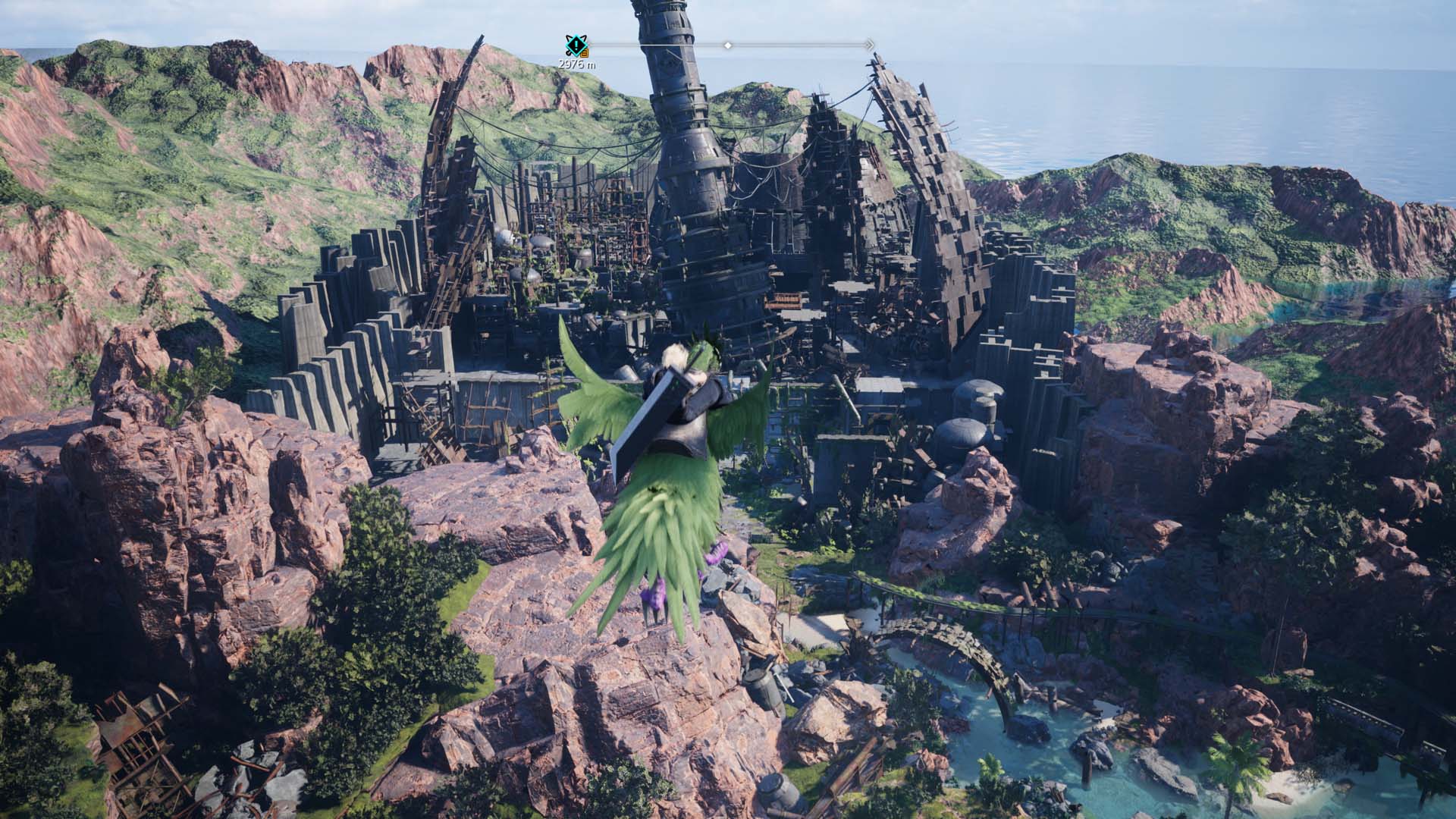
Me? Gongaga.
Besides offering aesthetic variety, these different biomes result in varied level design across the game. In particular, there’s an impressive level of verticality to each map, which will open up once you’ve obtained that region’s unique breed of Chocobo. This includes steeds that can ascend vertical slopes like mountains (Junon), bounce off mushrooms to soar high above the trees (Gongaga) and shoot a jet of water to glide short distances (Nibel). In the Corel region, you can even unlock an ATV-like buggy in a wonderful nod to the original VII. As I explored, I was delighted to find that I regularly had to consider how to reach a certain area; often, the path involved a well-concealed climbable path, a hidden cave or a rope to swing from, making exploration feel gratifyingly more involved.
The breadth of traversal options ensures that exploring each region feels consistently engaging, and that’s before you even get into the plethora of side content within each of them. Admittedly, a lot of this follows a somewhat derivative structure. On a base level, there are ‘Remnawave Towers’ that you’ll ascend to reveal parts of the map, which feel too similar to the tired ‘Ubisoft Tower’ trend. I recommend trying to come across these points of interest naturally, especially since some of them can also be found by following cute animals in the environment, Ghost of Tsushima-style. Outside of that, you have the likes of Summon Crystals (housed in hidden little shrines in which you can level up your Summon Materia), Lifesprings (awe-inspiring wells of natural planetary energy that reveal points of interest), Excavation sites (ramshackle areas in which your Chocobo can sniff out new items to ‘transmute’ in a surprisingly robust crafting system) and Combat Assignments (tougher unique creatures).
Even if these can feel like checklists at times, given the number of them in each region, I appreciated how Square Enix injected them all with bits of worldbuilding thanks to Chadley, the Shinra researcher and secret ally first introduced in Remake. Whether it’s learning about how the denizens of each region viewed its historical deity, uncovering more of the history behind the various major cities, or even just seeing the remnants of older civilizations, I developed a deeper appreciation for the world simply by completing these basic tasks and listening to Chadley share his data with me.
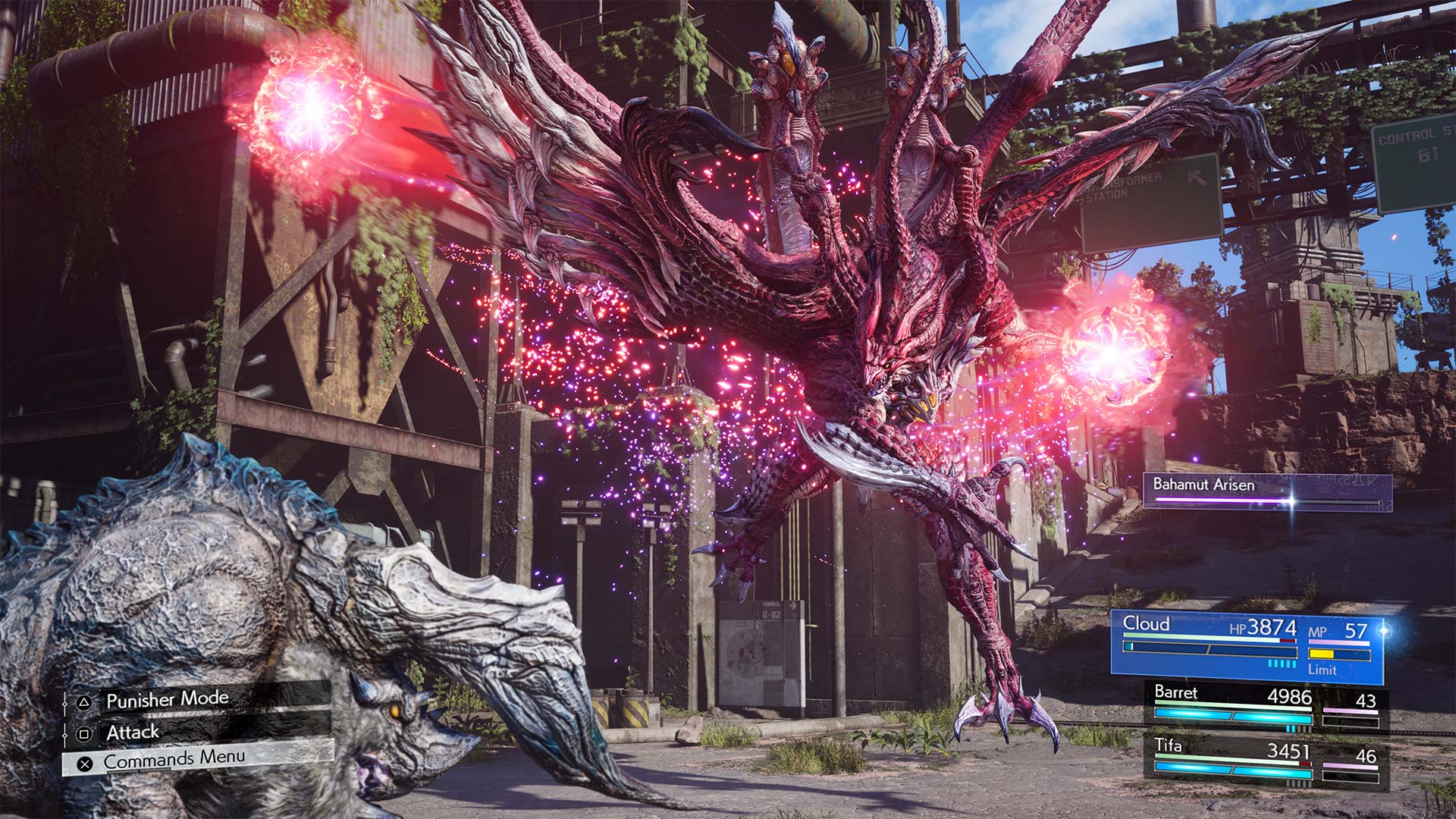 Of course, Rebirth also offers more tailored sidequests, and these are significantly better than those found in its predecessor. Many of these are tied to specific characters to provide further insight into them, like Barret helping the mild-mannered bespectacled author of his daughter Marlene’s favourite book, Tifa aiding an elderly disabled man get a sighting of a famed condor or snapping photos of celestial phenomena around Red XIII’s home of Cosmo Canyon and marvelling at them with Aerith. Once again, it’s these smaller-stakes activities that often lie at the heart of Rebirth, giving you heartwarming scenes between Cloud and his friends. (They’ll also help you work towards an expanded version of VII‘s iconic Gold Saucer date scene, and you’ll be able to check your favour with a given party member at any given time if you’re seeking a specific pairing.)
Of course, Rebirth also offers more tailored sidequests, and these are significantly better than those found in its predecessor. Many of these are tied to specific characters to provide further insight into them, like Barret helping the mild-mannered bespectacled author of his daughter Marlene’s favourite book, Tifa aiding an elderly disabled man get a sighting of a famed condor or snapping photos of celestial phenomena around Red XIII’s home of Cosmo Canyon and marvelling at them with Aerith. Once again, it’s these smaller-stakes activities that often lie at the heart of Rebirth, giving you heartwarming scenes between Cloud and his friends. (They’ll also help you work towards an expanded version of VII‘s iconic Gold Saucer date scene, and you’ll be able to check your favour with a given party member at any given time if you’re seeking a specific pairing.)
But the highlight by far is a region-spanning quest to investigate mysterious ‘Protorelics’ that not only features welcome cameos from some surprise characters from Remake and Intermission, but also the fan-favourite Final Fantasy antagonist Gilgamesh. I wouldn’t dare spoil how that all plays out, but suffice it to say that I was eager to learn more about what the endearingly goofy six-armed warrior was up to as a fan of the larger series. Regardless of what you tackle, Rebirth has an astonishing amount of content, and it’s almost always rewarding, both from a narrative and gameplay perspective.
A reunion unlike any other
As the credits rolled on Rebirth, I found tears streaming down my face. Not necessarily because of the ending or even the reprisal of Allred’s heartfelt ballad, as effective as they were, but more so due to the unbelievable quality of the experience as a whole. While some characters and side activities could have been better fleshed out, everything else is executed just brilliantly.
From the more introspective story and layered combat to meaningful environmental and side quest design that deepens your connection to the world of Final Fantasy VII, I was consistently in awe during my time with Rebirth. Not only is this gaming’s best and most thoughtful remake — it’s a must-play PS5 game and one of Square Enix’s greatest creations to date.
It remains to be seen whether the third game will stick the landing, but Rebirth has reminded me what’s important is the quieter moments along that journey, and those are precious things that I’ll never forget.
Final Fantasy VII Rebirth will launch exclusively on PlayStation 5 on February 29th for $89.96. A free demo is available in the PlayStation Store.
MobileSyrup utilizes affiliate partnerships. These partnerships do not influence our editorial content, though we may earn a commission on purchases made via these links that help fund the journalism provided free on our website.
Image credit: Square Enix
MobileSyrup may earn a commission from purchases made via our links, which helps fund the journalism we provide free on our website. These links do not influence our editorial content. Support us here.

